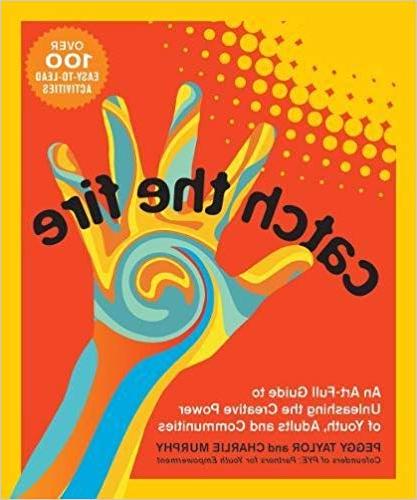Introducing the School Arts Plan to Staff
让你的员工兴奋起来,准备好参与实施艺术计划
Start with an art-making activity
Demonstrate how even a short arts making experience can warm up people for learning and support important student habits such as creativity, communication and collaboration.
以下是向员工介绍艺术计划时可以使用的两个示例活动. Both come from the book,抓住火: An Art-Full Guide to Unleashing the Creative Power of Youth, Adults, and Communities by Peggy Taylor and Charlie Murphy. 这是在秋季艺术团队启动会议上提供给每个艺术团队的书.
视觉艺术活动: Pass Around Drawing
Theatre Activity: This Is Not A…
这是盖尔·塞霍斯特提出的另一个戏剧艺术融合课程
戏剧-文学艺术整合动态理解教案
Introduce the Arts Vision and Arts Action Plan
Distribute copies of the Arts Plan in advance to all staff and ask everyone to read in advance. Also bring hard copies of the plan to the meeting for participants to review during the conversation.
介绍艺术团队成员,包括艺术团队负责人. Have members of the Arts Team or larger faculty read elements of the School Arts Vision aloud. Then have participants look at the School Arts Plan and its major initiatives or goals.
Facilitate the Focused Conversation below, using a selection of questions that best fit your situation.
目标问题:
- 当你回顾计划时,哪些单词或短语对你来说很突出? [在房间里绕一圈,让每个人回答第一个问题.]
- 对学校艺术愿景的要素有什么问题吗?
- What goal stands out for you?
- What catches your attention about the steps in the plan?
- Who are some of the key players who will implement the plan?
Reflective questions:
- What excites you about the plan?
- 当我们看到这个计划的目标时,什么对我们来说是最容易的?
- What will be more challenging to accomplish?
Interpretive questions:
- Which elements of the Arts Vision and the Arts Plan might family members respond to most favorably?
- 如果我们学校今年只能完成一件事,那会是什么?
- 你对我们如何实现这一目标有什么见解?
- What strengths or resources can we take advantage of in the next two years to build the arts at our school?
Decisional questions:
Document the answers to these questions.
- What are some of the first steps we need to take as a staff?
- What kind of support needs to be put in place to assist the teaching staff in implementing the Arts Plan?
- What kind of structure (committee or scheduled check-in points) will help us to communicate and stay on track with the Arts Plan? (理想情况下, each arts Plan goal already has an identified point person who will shepherd the work forward. Consider having this person announce the goal, describe their excitement about it, and enlist volunteers to work with them. Record the names of new volunteers.]
- Who can we reach out to for help and support?
- What does each of us need to do first?
后续
In a follow-up email or a note in meeting minutes that are shared with all participants, recap the answers given to the decisional-level questions and remind everyone of the workgroup assignments and point people.
介绍学校艺术计划的技巧及要点
Here are some suggestions and ideas from principals who have completed school arts planning:
- Use a full staff meeting soon after the plan completion.
- Obtaining a critical mass is key to developing buy-in and advancing the plan in a sustainable way. 因此, it’s important to find a time to share information about the School Arts Plan when you have the whole staff together.
- Provide staff with an initial arts experience (such as one of the arts activities from the PAL Catalyst Workshop Module). Then have staff debrief or reflect on the experience as a group so that the value of the activity becomes clear.
- Have each Arts Team member who is a point person for an Arts Plan goal speak briefly about what they will be doing. Following the presentations, ask for volunteers from the staff to help with each area or project so that there is a small committee established for each goal (see Decisional questions).
- Create momentum and make the plan common knowledge:
- Create a display of the Arts Team members, 照片, bios, and some of the artwork they made at the Catalyst Workshop.
- Incorporate your Arts Plan into grade-level or school improvement plan professional learning communities. Consider asking each grade level to come up with their own commitments in the arts for the year and to request appropriate professional development to support their commitments.
- Introduce one action step per quarter or trimester.
- Roll out the plan in small pieces. Maybe focus on only one goal at a time. 把某件事做好,而不是在太多的计划上浪费时间.
- Include one arts experience at every staff meeting. 或者每年至少举行三次以艺术为主题的会议.
- Pick low-hanging fruit. What’s already going on? 你如何在一个已经存在的领域或项目中迈出下一步?
Be explicit when speaking with staff
- 承认这需要时间,并不是每个人一开始都会接受这项工作. 也许不是计划中的所有事情都能在头两年完成.
- 要知道这是一个不断的杂耍行为,所有的校长都有优先考虑的事情.
- Remind your staff regularly that arts education and the School Arts Plan are priorities, so that staff members maintain awareness and commitment.
- Encourage everyone to work together, as well as to do the things each can do individually, 所以总的来说, 学校可以保证重要工作的完成或推进.

